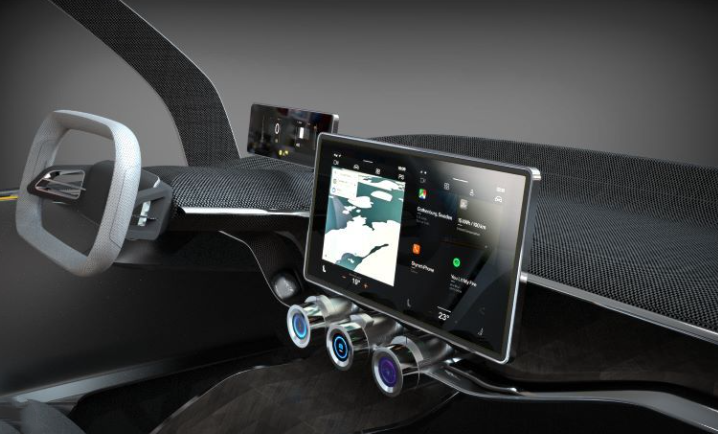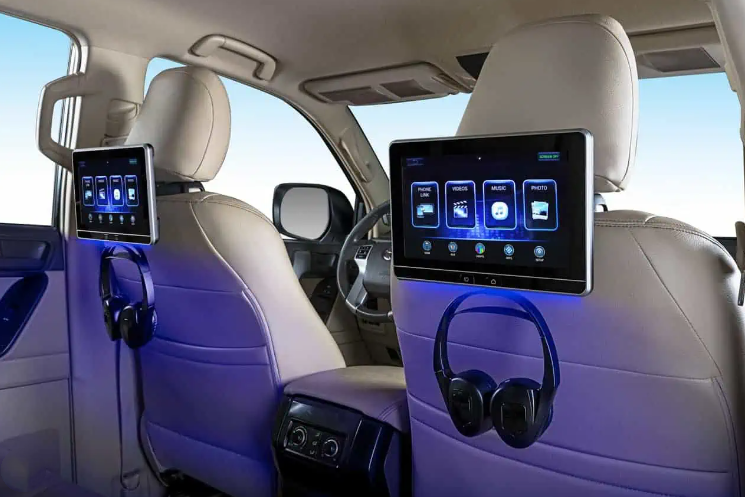The global in-vehicle display market is developing rapidly. Under the trend of automobile intelligence, in-vehicle displays are becoming larger and more multi-screen. On the other hand, demand is driving the upgrade of display technology, which has led to an increase in the unit price of in-vehicle displays. Under the trend of "increasing both quantity and price" in the in-vehicle display market, the global in-vehicle display market space is growing rapidly. This article will introduce you to the application of display screens in the automotive field.
Depending on the placement position, the types of display screens in the car are divided into central control display screen, LCD instrument panel, head-up display, co-pilot and rear seat entertainment screens, side view screens, rearview mirror screens, etc.
LCD instrument:It is a necessary display screen in the car display, which can display the status of the car to the driver, including mileage, speed, fuel, door, seat belt status and other information. Every car must have this kind of display screen, because the driver must clearly understand the status of the car during driving in order to drive safely and smoothly. The car dashboard only needs a simple display function. The segment display screen has the advantages of flexible customization, low price and simple display content, making it the most commonly used display screen for car dashboards.
Central control display:
The central control display screen is the display screen with the highest penetration rate and is also the most basic type of display screen. Its function is to provide driving assistance such as reversing images and navigation, control in-car equipment such as air conditioning and audio, and also has entertainment functions.
As the trend of automobile electrification, intelligence, and networking continues, the in-vehicle display screen, as the main interface for human-vehicle interaction, is showing a trend of high-end and large screens.
In terms of appearance, the automotive glass cover plate has developed from 2D to 2.5D and 3D. Compared with the traditional 2D plane, the advantage of 3D display screen is to improve the design freedom and tactile feedback, and it is more ergonomic.
In terms of structure, it has developed from simple display to integrated touch display, which is mainly manifested in the integration of display to touch display in structure, from plastic to glass in material, and from 2D to 3D curved surface in appearance.
In terms of materials, the in-vehicle cover plate has developed from plastic to glass. With the trend of intelligent vehicles, as the demand for in-vehicle display and human-vehicle interaction increases, glass materials with high light transmittance, scratch resistance, better touch feel and relatively easy to make into 3D structures have begun to become the preferred cover material for in-vehicle display panels. From the perspective of technical path, capacitive screens are currently the main touch screens, and it is expected that capacitive screens will develop in the direction of lightness and thinness in the future, further replacing resistive screens.

In-car entertainment display
Whether in large buses or private cars, "small TVs" that can play videos, music, etc. are commonly seen. The display screen that can support such functions requires high resolution, large size, and support for video and audio functions. It can be a simple LCD screen with only viewing function, and some are with touch function. Users only need to touch to achieve control, providing users with entertainment functions.

Parameter requirements for vehicle display
As the third space of future life, the car's smart cockpit needs to provide consumers with a better immersive experience. The display screen is the main interface for passengers to obtain vehicle and related information. In order to ensure the normal operation of the display screen, all aspects of the display screen must meet certain requirements.
1. High temperature resistance. Since vehicles may travel in different seasons and at different latitudes, the in-vehicle display screen needs to be able to ensure normal use within a wide temperature range. Therefore, temperature resistance is a basic quality. The current industry requirement is that the display screen as a whole reaches -40~85℃
2. Wide viewing angle. The driver and passengers (including rear seat passengers) should be able to see the central control display screen.
3. High dynamic HDR. The quality of the picture display requires a comprehensive balance, especially the real feeling and coordination of the image. This concept is HDR (High Dynamic Range). Its actual effect is that the brighter the moon is, the darker the darker the darker the darker the darker the bright and dark details are well displayed.
4. Fast response time and refresh rate. Smart cars, especially autonomous driving, need to collect road information in real time and remind the driver in time at critical times. Fast response and refresh can avoid information transmission lag, which is essential for warning indicators and navigation functions (such as real-time maps, traffic information updates and backup cameras).
5. Long service life. In short, the in-vehicle display screen must support at least five years of design and production cycle. Due to vehicle warranty reasons, this period should be extended to 10 years. Ultimately, the life of the display should be at least as long as the life of the vehicle.
6. High brightness. It is crucial that the driver can easily read the information on the display in different ambient light conditions (from bright sunlight to complete darkness).
7. High resolution. High resolution means that there are more pixels per unit area and the overall picture is clearer.
8. High contrast. The contrast value is defined as the ratio of the maximum brightness value (full white) divided by the minimum brightness value (full black). Generally speaking, the minimum contrast value that the human eye can accept is about 250:1. High contrast is beneficial for seeing the display clearly in strong light.
9. Wide color gamut. High-resolution displays may need to be upgraded from 18-bit red, green and blue (RGB) to 24-bit RGB to achieve a wider color gamut. High color gamut is a very important indicator for improving display effects
10. Anti-glare and reduced reflection. The on-board display provides key vehicle information to the driver and needs to be visible without reducing visibility due to ambient light conditions (especially during the day when the sun is strong). Of course, the anti-glare coating on its surface cannot hinder visibility (need to eliminate "flicker" interference).
11. Low energy consumption. The significance of low energy consumption is that it can reduce the energy consumption of the vehicle, especially for new energy vehicles, more electricity can be used for mileage; in addition, low energy consumption means reducing heat dissipation pressure, which has positive significance for the whole vehicle.
For more information about automotive displays, please contact us directly!